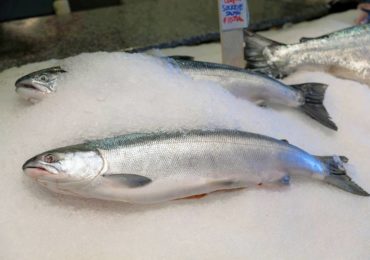 When it comes to seafood, there is really no such thing as an organic label. The U.S. Department of Agriculture standard for organic labeling is based on soil treatment and organically grown feeds, so of course, those standards do not apply to water.
When it comes to seafood, there is really no such thing as an organic label. The U.S. Department of Agriculture standard for organic labeling is based on soil treatment and organically grown feeds, so of course, those standards do not apply to water.
As the world population demands for seafood increase and many native species are at risk of depletion, farm-raised saltwater and fresh-water species are becoming an increasingly popular option. As aquaculture increases, so does the complexity of the issue for consumers, in terms of purchasing the most healthy and sustainably grown options.
Fortunately, there are several businesses and organizations monitoring this issue for us, and with a little digging, you can make the best choices for your table. There is worldwide concern regarding the degradation of the environment when fish and shellfish are raised irresponsibly or unsustainably.
In 2004, National Geographic published a study on shrimp farming in Asia and concluded “the impacts of shrimp farming range from wrecked mangrove forests and decimated wild fish stocks to pollution- and disease-prone coastal communities.”
A shrimp farm costs little to set up and appeals to those who want to get rich quick, but when created and maintained irresponsibly, it takes a great toll on the environment. Mangrove swamps serve as safety nets for fragile seaside communities by protecting land from sea surges.
Shrimp farmers clear out the mangrove trees and build artificial ponds in which to raise shrimp. These ponds quickly become contaminated by overcrowding, massive use of chemicals such as pesticides, antibiotics and shrimp feces, and as a result will no longer sustain life.
A bulletin from the American Museum of Natural History says, “The average Asian intensive shrimp farm survives only two to five years before pollution and disease force it to shut down. Local people are left with a devastated landscape that can no longer support fishing, farming, or wood gathering, and many are forced to move away.”
Fin-fish farming is also problematical if done irresponsibly, as recent news stories on salmon pens in Puget Sound show. Fortunately, with awareness comes change, and there are great strides in improving the fish farming industry. Real success stories come from Norway and Iceland, where cold, clean water that moves rapidly promotes healthy growth of salmon and arctic char.
Problems facing fish farms range from infestations of sea-lice to finding fish meal, which is sustainably harvested and produced. As our demand for seafood continues to increase, more and more of it will have to be farmed as opposed to being wild caught.
The Pacific Northwest is home to Alaska seafood, which is one of the most sustainably managed wild fisheries in the world. The Alaska Seafood Marketing Institute’s website explains the life cycle of the salmon, and how 100 percent of the catch is utilized, eliminating waste. Wholefoods Market also has a paper on its responsible approach to overseeing suppliers and verifying that their products come from sustainable sources.
Perhaps the quintessential source for consumers who are interested in eating sustainably raised or fished seafood is Seafood Watch, developed by the Monterrey Bay Aquarium in the late 1990s. SeafoodWatch.org produces several wallet-sized pamphlets for various regions of the country with “best, “good” and “avoid” recommendations for seafood choices. The fish and shellfish varieties for each category are based on environmental sustainability and fishing stocks. There is now also an app for smartphones.
Consumers are a powerful force for change by only buying healthy and sustainable seafood, asking grocers and restaurants alike about the source of their offerings.
READ MORE IN THIS SERIES• Why Buy Organic? Part 1: Fruits and Vegetables
• Why Buy Organic? Part 2: The Dirty Dozen and the Clean 15!
• Why Buy Organic? Part 3: Top Reasons to Consider Buying Organic Meats and Poultry
• Why Buy Organic? Part 4: Seafood
























